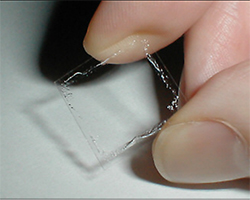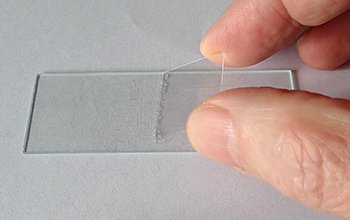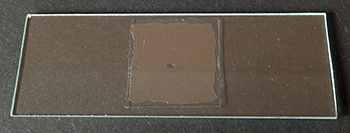 There are some types of temporary slide preparations where a complete even seal around the coverslip border is required. Notably for Brownian motion studies where it is essential to prevent currents caused by solvent evaporation at the slip edges. Such currents can swamp the subtle Brownian movement.
There are some types of temporary slide preparations where a complete even seal around the coverslip border is required. Notably for Brownian motion studies where it is essential to prevent currents caused by solvent evaporation at the slip edges. Such currents can swamp the subtle Brownian movement.
In a past 'how to' for studying Brownian motion in very dilute milk I suggested a needle to lay down a line of Vaseline along a square slip edges, as shown right. This method gives rather uneven seals and can give thick liquid films. A better method was described in the May 1998 Micscape issue by the, sadly now late, Bill Ells, a stalwart contributor to Micscape in the early years with a specialism in desmids and their identification. He noted the value of sealed slips of aqueous mounts for live extended studies of desmids. It's also appropriate for some microorganisms which can also benefit from a total seal if the critter can tolerate for a while the decreasing oxygen levels in the water.
Bill recommended a neater approach by drawing all four edges of a square coverslip across a thin smear of Vaseline on a microscope slide (below right). Being intrinsically lazy and seeking any excuse not to clean greasy glassware, I often smear a very thin Vaseline film on the fleshy area below my thumb and stroke the slip edges across the skin (below left). Some control of the film thickness can be made by how firmly press the slip on skin (or for Bill's method the length that draw the slip across the side) as can see the line of Vaseline build up.
Image above - less successful application of Vaseline with a needle.
It's worth trying both methods to see which is preferred. For me, the thumb base method seems to give a more even and controllable thickness of Vaseline.


Better control either by drawing the edges of a slip either across smeared thumb base or along a smeared slide (the latter as described by Bill Ells).
Once a small droplet of sample has been placed on the slide the slip is lowered carefully on. Gently tap along the coverslip edges with a needle until can see a complete seal all round which should remove the possibility of any evaporation. The extent of tapping can control the liquid thickness somewhat.

Check a perfect seal all round by gently tapping along edges with a needle, which can also control film depth to some extent if liquid drop is not too large.
Vaseline is also widely recommended and used for controlling the water film thickness when studying an aquatic microorganism by just putting four Vaseline blobs on each corner of the slip. Again gentle tapping of the slip can control the film thickness and excess liquid can escape. This method also potentially acts as a temporary compressorium if can just tap down the slip enough to gently immobilise the organism being studied but does not of course prevent evaporation. Although water can be added if necessary along the slip side.
Immobilising a coverslip with Vaseline is also useful for oil immersion objective studies of temporary aqueous mounts.
The compiler David Walker welcomes any comments.